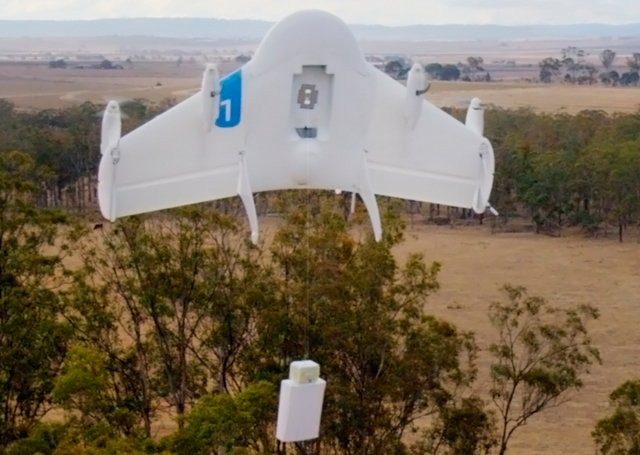Dave Vos flew radio-controlled aircraft in his native South Africa as a teenager until the hobby began to bore him.
“I started dreaming of, ‘why don’t we make this completely automatic’?” Vos recalled about 40 years later, speaking at the ICAO remotely piloted aircraft symposium in Montreal on 23 March.
Now the head of Project Wing for Google, Vos is in a position to make his dream a reality. The ex-founder of Athena Technologies and Rockwell Collins executive is tasked with solving the problem of autonomous commercial package delivery by air.
The US Marine Corps has demonstrated autonomous delivery with the Lockheed Martin/Kaman K-Max unmanned helicopter since 2012 in the remote mountains of Afghanistan. But that experience bears little relation to Google’s long-term goal: integrating autonomous flying vehicles into congested airspace above the world’s largest cities, replacing delivery trucks and cars for small package delivery.
Google launched Project Wing two and a half years ago under Nicholas Roy, a robotics expert and professor at the Massachusetts Institute of Technology. Roy’s team had hoped to simply procure an unmanned air vehicle to launch experiments, but could not find a system that met their needs, according to Astro Teller, head of the Google X Moonshot group, which includes Project Wing.
Instead, Project Wing designed a tailsitter aircraft that could take off vertically and then pitch over to become a flying wing, said Teller, speaking at the South by Southwest media festival in Austin, Texas, on 17 March.

Flawed: tailsitter design
Project wing
“We worked on it hard. And it just wasn’t the right answer. It was a failure,” Teller says.
Google could reveal Project Wing’s new design later this year, Teller adds. But the tailsitter was used to unveil Project Wing to the world in a 2min video posted on YouTube on 28 August. The video showed the tailsitter successfully delivering a rawhide treat to a neighbour’s dog on a test site in the Queensland territory of Australia.
At the time the video was released, the project team already knew the tailsitter design was flawed. Google founder Sergei Brin had given the team a five-month deadline to begin flight testing, Teller says, so the tailsitter had to be used.
“We just got a big chunk of learning,” Teller says. Those lessons were “rushed into the new vehicle design”.
The project’s atmosphere also evolved once Vos assumed control. Vos has a rare mix of experience as a pilot, an autonomous aircraft experimenter and an aerospace industry executive. He immediately began working to change the culture of Google’s project team. The traditional software industry practice of releasing new products and then fixing the bugs does not work in the highly-regulated and safety-conscious aerospace industry.
“We want to collaborate with air traffic control people,” Vos says. “We want to collaborate with the industry at large that flies very large airplanes around the world, the pilots that fly those machines and the public that expects nothing is going to fall on their head just because we’re not being responsible and safe and building reliable systems.”
Project Wing has added a new challenge to an already long list associated with a commercial autonomous delivery system. As the newcomer to the airspace, Vos says, Google wants to design an autonomous system that does nothing to inconvenience or displace existing users of the system, whether they are an international airline or a private aircraft owner flying for fun.
“I think this should be music to the aviation industry’s ears,” Vos says.
That can be accomplished partly by operating in low-altitude airspace under 500ft that is largely unoccupied by manned aircraft today, he says. It can also rely on autonomous software that includes a “Moses” mode, in which all the UAVs move out of the way of a manned aircraft rather than the other way around.
There are still practical challenges to achieving Google’s vision, however. The so-called Moses mode will not work unless every user in the airspace is equipped with an automatic dependent surveillance-broadcast (ADS-B) transponder. The US Federal Aviation Administration is mandating ADS-B Out compliance for all aircraft using Class A, B and D airspace by 2020. But there could still be hundreds or even thousands of aircraft owners who choose to continue flying in non-controlled airspace.
But Google still has an answer for even this challenge. Vos has revealed plans within Google to develop an ADS-B transceiver priced so low that it would compel aircraft owners to equip with the device. Right now, the lowest-priced, compliant transceivers sell for about $2,000, excluding installation costs.
“There are easy ways, we think, to get small UAVs in the airspace today that allow us to go and field highly automated systems and be completely respectful of manned aviation as it exists today,” Vos says.
Source: FlightGlobal.com























